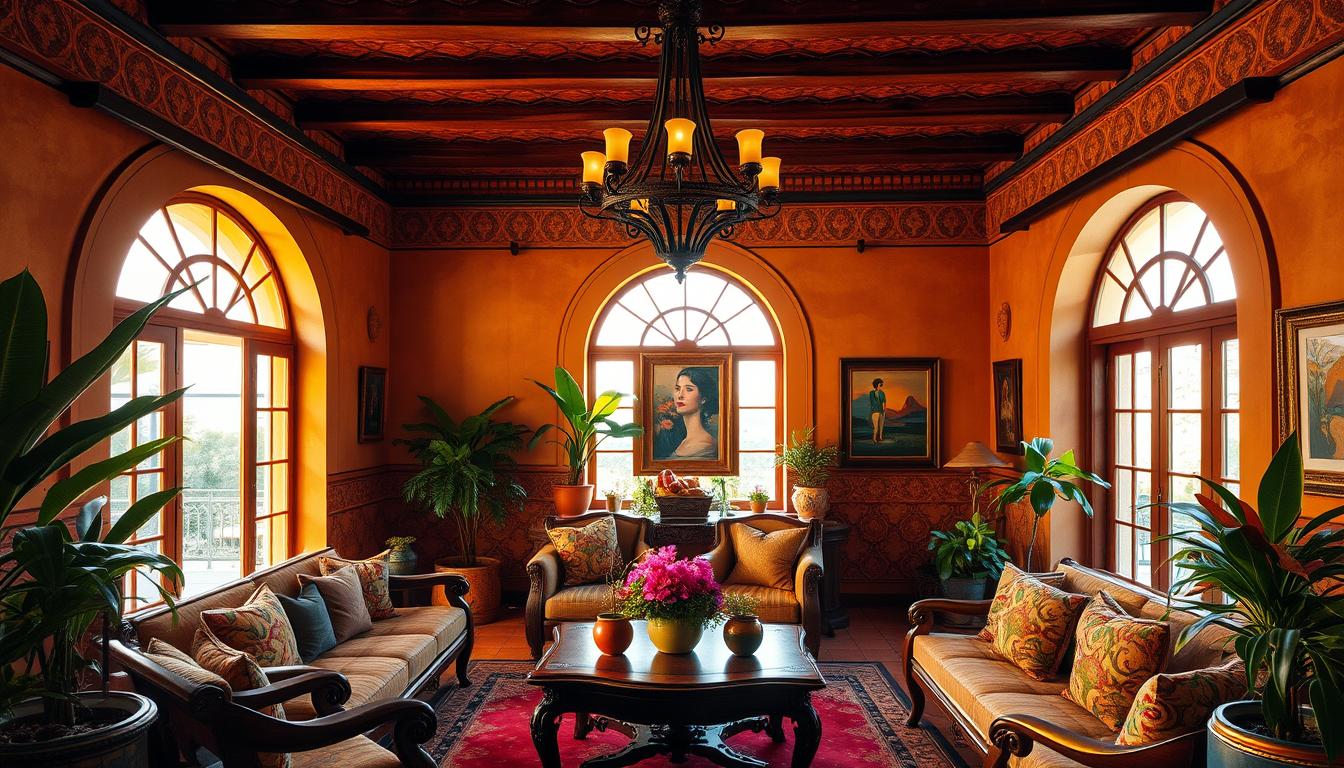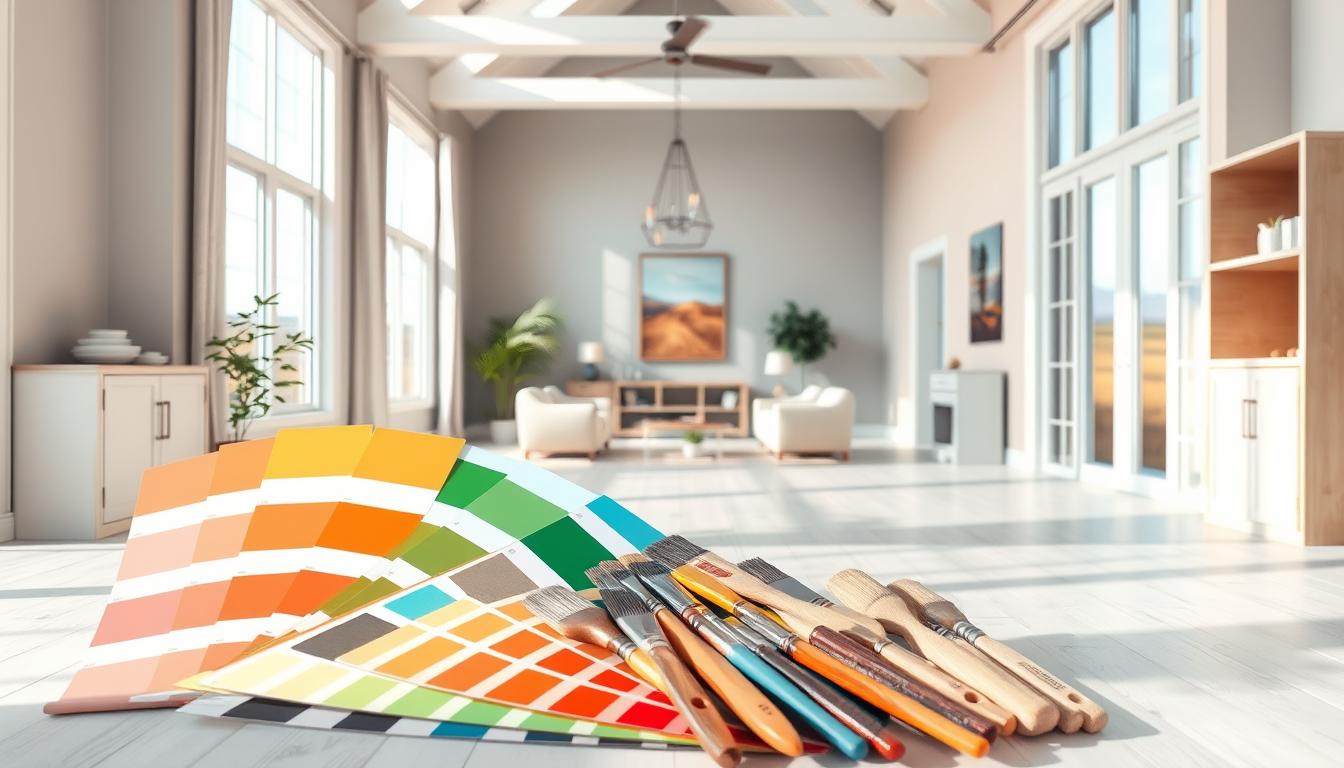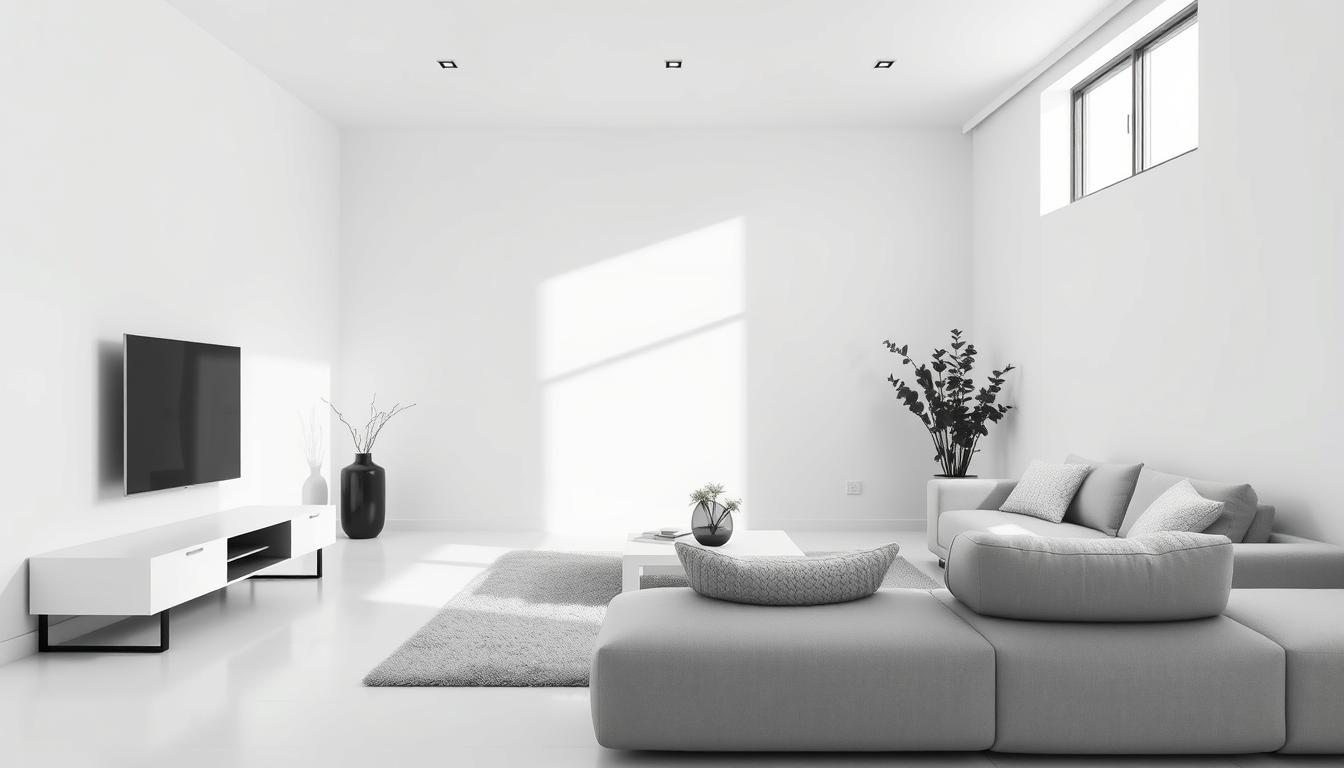Did you know Spanish-style homes are getting more popular in the U.S.? They’re loved for their warm, welcoming look. This style comes from Spain’s rich history, adding elegance and charm to any room.
We’re excited to share our detailed interior design guide. It’s all about Spanish-style interiors. You’ll learn about their history, decorating tips, and more. Discover the key elements that make these interiors special, like colors, furniture, and decorations that reflect Spanish culture.
Key Takeaways
- Explore the history and architectural heritage behind Spanish-style homes.
- Discover characteristic color schemes and furniture typical of Spanish-style interiors.
- Learn practical decorating ideas to bring the charm of Spanish culture into your home.
- Understand the essential elements that define Spanish-style interiors.
- Get inspired by the warmth and elegance of Spanish home decor.
Overview of Spanish-Style Homes and Their Charm
Spanish-style homes have won over many with their rich history and unique charm. They mix old-world influences with modern beauty, offering a special way to live.
History of Spanish Architecture
The story of Spanish architecture is filled with cultural mixtures, from the Moors to the Romans. This mix has shaped the look of Spanish-style homes today, with stucco and ornate tile.
Looking at Spanish architecture’s growth, we see how Mediterranean interiors have influenced it. Features like arches and courtyards bring a warm, welcoming feel.
“The beauty of Spanish-style homes lies in their ability to evoke a sense of history and culture, while providing a comfortable and elegant living space.”
Key Features of Spanish-Style Homes
So, what makes a Spanish-style home? Key features include stucco or adobe exteriors, curved lines, and ornate tile work. These, along with clay tile roofs and iron details, make the exterior stand out.
- Stucco or adobe exteriors
- Curved lines and arches
- Ornate tile work and clay tile roofing
- Decorative ironwork
Popular Regions for Spanish Revival Architecture
Spanish Revival architecture is popular in Florida and California. In Florida, it’s linked to the Spanish Colonial Revival of the early 20th century. In California, it celebrates the state’s Spanish roots.
These places have made Spanish Revival interior design their own, blending local touches and materials. This makes Spanish-style homes in these areas not just beautiful but also deeply connected to their culture.
Color Schemes That Define Spanish Interiors
Spanish interiors are known for their warm and inviting colors. These colors come from Spain’s rich architectural history. Earthy tones, vibrant accents, and textured materials make Spanish-style homes unique.
Warm Earth Tones
Warm earth tones are key in Spanish decorating. Colors like terracotta, sienna, and golden hues remind us of Spain’s sun-kissed landscapes. These colors make any room cozy.
“The use of terracotta and other earthy tones in Spanish architecture is not just aesthetically pleasing; it’s also a reflection of the country’s cultural and geographical identity,” notes an interior design expert. Natural materials and colors bring the outdoors inside, blending indoor and outdoor spaces seamlessly.
Bold Accent Colors
Bold accent colors are also important in Spanish interior design. Colors like turquoise, cobalt blue, and deep reds add a pop of color. These vibrant hues are used in decorative tiles, textiles, and accessories, adding depth and personality.
- Turquoise tiles are a classic accent color in Spanish interiors, often used in kitchens and bathrooms.
- Cobalt blue adds a dramatic touch, particular in ceramics and glassware.
- Deep reds and burgundies are used to add warmth and coziness, often in upholstery and rugs.
The Role of Texture in Color Choices
Texture is key in Spanish interiors. Natural materials like wood, stone, and clay are visually appealing and add a tactile dimension. Different textures and colors create a rich, layered visual experience, making the space inviting and authentic.
The rough texture of terracotta tiles looks great with the smoothness of wooden beams. This contrast adds depth to the room. Woven textiles and rough-hewn stone also add warmth and coziness, making the space feel more lived-in.
Essential Elements of Spanish-Style Home Interiors
Spanish-style homes are known for their unique interior elements. These homes mix traditional touches with a cozy feel. This blend creates a warm and inviting space.
Arched Doorways and Windows
Arched doorways and windows are key features of Spanish homes. They add elegance and connect the home to Spanish history. The stone or stucco details make them even more beautiful.
These elements also link the inside with the outside. This makes the home feel open and connected to nature.
Clay Tile Roofing and Flooring
Clay tiles are crucial in Spanish interiors. They’re used for roofs and floors, adding warmth and charm. The tiles’ earthy colors match Spanish decor, making the home feel welcoming.
Clay tiles are also durable and practical. They keep the home cool and protect it from the weather. On floors, they create stunning patterns.
Decorative Ironwork
Decorative ironwork is a big part of Spanish homes. It’s seen in door handles, balconies, and lights. This work adds beauty and shows off Spanish craftsmanship.
Ironwork, from simple door handles to fancy balcony railings, is everywhere. It’s not just for looks; it also serves a purpose. It adds depth and interest to the home’s design.
Furniture Styles That Complement Spanish Interiors
To truly capture the essence of Spanish interiors, one must carefully select furniture that complements its distinctive style. The right furniture not only enhances the aesthetic appeal but also pays homage to the rich cultural heritage of Spanish design.
Rustic Wood Furniture
Rustic wood furniture is a staple in Spanish-style homes, adding warmth and coziness to the interior spaces. The use of solid wood, often with a distressed finish, brings a sense of authenticity and history to the rooms. Pairing rustic wood furniture with other natural materials like stone or leather enhances the overall ambiance, creating a harmonious and inviting atmosphere.
Wrought Iron Accents
Wrought iron accents are another essential element in Spanish interiors, introducing a touch of elegance and sophistication. The intricate designs and patterns characteristic of wrought iron work add a layer of complexity and beauty to the space. We often see wrought iron used in lighting fixtures, railings, and decorative accessories, which not only serve a functional purpose but also act as artistic statements.
Colorful Ceramic Pieces
Colorful ceramic pieces, such as vases, tiles, and pottery, are significant in adding pops of color and contributing to the vibrant, lively atmosphere of Spanish-style homes. The use of ceramics in various hues and designs allows for a creative expression of the Spanish style, making each piece unique. We recommend incorporating these colorful elements through decorative accessories or functional items like tableware to enhance the visual appeal of the interiors.
By incorporating rustic wood furniture, wrought iron accents, and colorful ceramic pieces, we can create a Spanish interior that is not only aesthetically pleasing but also deeply rooted in tradition. The key is to strike a balance between these elements, ensuring that each piece complements the others to form a cohesive and inviting space.
“The essence of Spanish design lies in its ability to blend tradition with elegance, creating spaces that are both beautiful and meaningful.”
Incorporating Art and Decor in Spanish Homes
Adding art and decor is key to capturing the essence of Spanish homes. It blends tradition with elegance. The interiors show Spain’s rich cultural heritage, with elements that reflect its history and mythology.
Traditional Spanish Tilework
Spanish home decor is known for its traditional tilework, or “azulejos.” These tiles are not just beautiful but also tell stories of Spanish history and mythology. The craftsmanship in these tiles is amazing, with designs passed down through generations.
Azulejos have been used in Spanish homes since the Moorish period. Their influence is still seen in modern Spanish revival interior design. These tiles add authenticity to any room with their stunning visual displays.
Influential Artists and Designers
Spanish art and design have been shaped by many influential artists and designers. Antoni Gaudí and Joan Miró, for example, have made a lasting impact on Spanish interior design. Their work inspires new designers.
Their contributions to Spanish revival interior design are clear. They used bold colors, unique textures, and innovative materials. By using these elements in our homes, we can bring Spanish style to life.
Cultural Artifacts and Their Significance
Cultural artifacts are crucial in Spanish home decor, adding depth and character. Antique furniture, textiles, and other artifacts are valued for their historical significance and beauty.
These artifacts often share stories of Spain’s rich cultural heritage. They give us a glimpse into its history and traditions. By using them in our decor, we can create a truly authentic Spanish-style home.
| Cultural Artifact | Significance | Example |
|---|---|---|
| Antique Furniture | Reflects historical periods and craftsmanship | Ornate wooden chairs from the 18th century |
| Textiles | Showcases traditional weaving and dyeing techniques | Vibrant tapestries from the Andalusia region |
| Ceramic Pieces | Adds a touch of color and cultural heritage | Hand-painted ceramics from Valencia |
By carefully choosing these elements, we can make a Spanish-style home that is both beautiful and meaningful.
Lighting Choices in Spanish-Style Homes
In Spanish-style homes, lighting is more than just a need. It’s an art that blends function with beauty. The right lights can make the architectural features and cozy feel of these homes stand out.
Mediterranean Flair in Chandeliers
Chandeliers with a Mediterranean touch can be a stunning centerpiece in any Spanish-style room. They often have detailed metalwork, like wrought iron, and are decorated with glass or ceramic tiles. These reflect the rich culture of the Mediterranean.
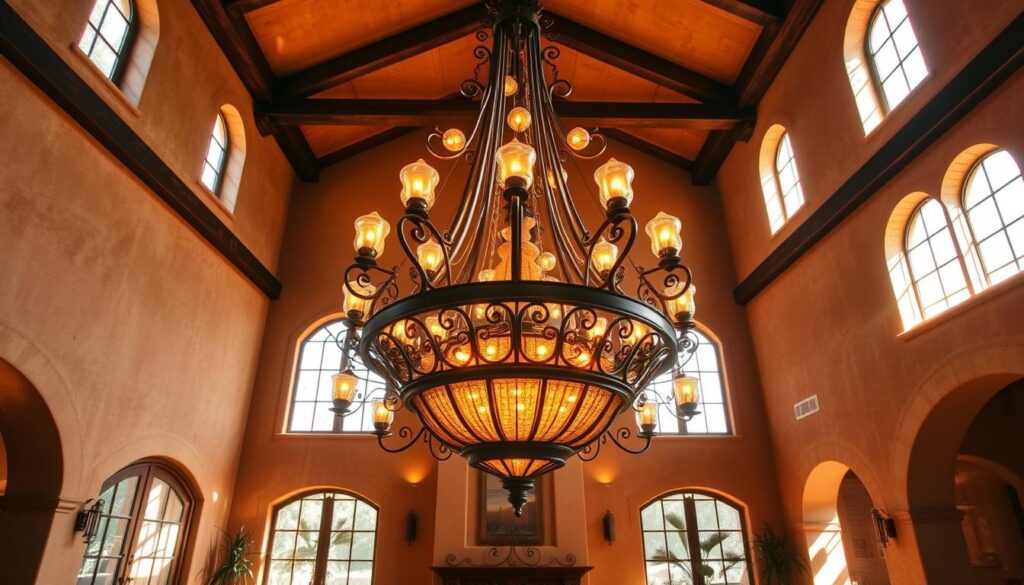
The Role of Natural Light
Natural light is key in Spanish-style homes. Big windows, often with arches or fancy carvings, let sunlight in. This highlights the beautiful tile work, wooden beams, and other details. Skylights also add to the natural light, making the home brighter.
Ambient Lighting: Creating Warmth
Ambient lighting is vital for a cozy feel in Spanish-style homes. It comes from table lamps, floor lamps, and string lights. These add depth to the lighting. Dimmers help adjust the light levels, perfect for different times.
| Lighting Element | Description | Effect |
|---|---|---|
| Chandeliers | Mediterranean flair with intricate metalwork | Creates a focal point, adds sophistication |
| Natural Light | Large windows and skylights | Illuminates architectural details, enhances ambiance |
| Ambient Lighting | Combination of table lamps, floor lamps, and string lights | Creates a warm, inviting atmosphere, adjustable ambiance |
Choosing and mixing different lighting options can make a Spanish-style home even more stunning. It creates spaces that are both beautiful and practical.
Landscaping and Outdoor Spaces
When we step outside Spanish-style homes, we find outdoor spaces that are just as beautiful as their interiors. The transition from inside to outside is smooth. Beautiful courtyards and patios act as extensions of the living area.
Courtyards and Patios
Courtyards and patios are key parts of Spanish-style homes. They offer peaceful spots for relaxation and fun. These areas often feature decorative tilework and wrought iron accents, matching the indoor architecture.
To make a courtyard or patio welcoming, add comfy seating, soft lighting, and greenery. Using native plants not only looks good but also saves time and effort in upkeep.
Water Features and Fountains
The sound of water is a big part of Spanish-style outdoor areas. Water features and fountains bring a calm vibe. They can be simple wall fountains or big courtyard fountains, each adding to the outdoor charm.
Think about the size and style of your space when adding water features. A small fountain can be a nice touch, while a big one can be a centerpiece, inviting you to relax.
Incorporating Native Plants
Using native plants in your landscaping is good for the environment and looks great. Native plants need less care because they’re used to the local weather. For Spanish-style homes, plants like lavender, rosemary, and olive trees are favorites, adding a Mediterranean touch.
| Plant | Characteristics | Benefits |
|---|---|---|
| Lavender | Drought-tolerant, fragrant | Low maintenance, attracts pollinators |
| Rosemary | Evergreen, aromatic | Culinary use, repels pests |
| Olive Tree | Evergreen, symbolic | Provides shade, Mediterranean aesthetic |
Designing your outdoor space with courtyards, water features, and native plants creates a beautiful extension of your Spanish-style home. It’s perfect for enjoying the outdoors.
Maintaining the Authenticity of Spanish-Style Interiors
Keeping Spanish-style homes true to their roots needs careful thought in interior design. It’s about mixing old charm with today’s needs. This way, the special feel of these homes stays intact.
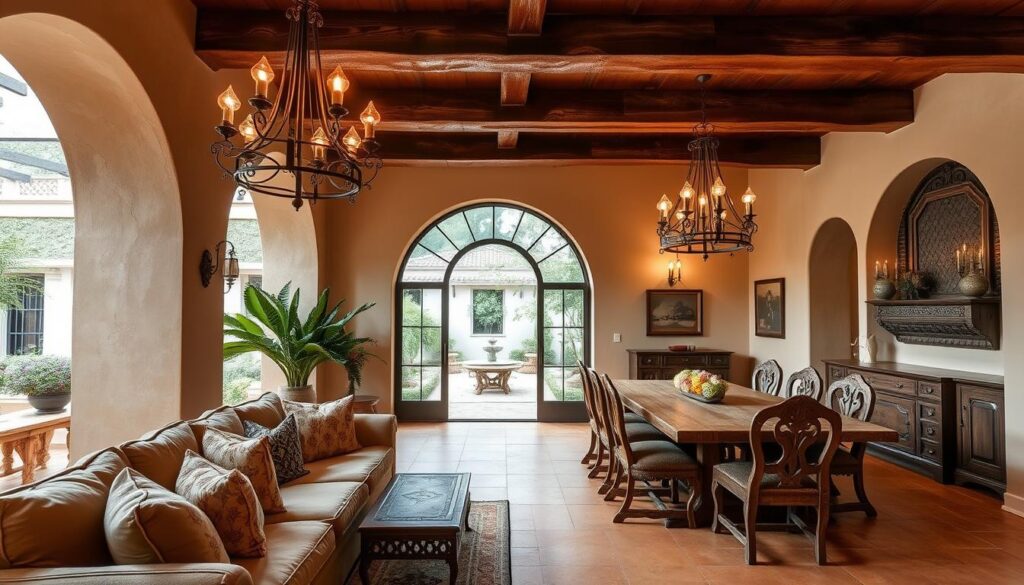
Choosing the Right Materials
Choosing the right materials is key to keeping Spanish-style interiors real. Authentic tiles, like Terracotta or Glazed Ceramic, are vital for floors and walls. Also, woodwork, like cedar and pine, is used a lot in furniture and building details.
Modern Upgrades While Preserving Tradition
Adding modern touches to Spanish-style homes can be tough. But, it’s doable without losing their classic look. For example, putting in energy-efficient appliances and modern plumbing makes life easier. Yet, it keeps the home’s old-world charm.
Tips for Renovating with Authenticity
Renovating a Spanish-style home needs careful planning to keep it true to its roots. Here are some tips:
- Use traditional materials whenever possible.
- Consult with architects or designers who specialize in Spanish-style homes.
- Pay attention to details such as ornate ironwork and decorative tilework.
By following these tips, homeowners can keep their Spanish-style interiors authentic and stunning for years.
Conclusion: Embracing the Spanish-Style Lifestyle
Exploring Spanish-style homes reveals a mix of warmth, character, and cultural heritage. Living in one offers many benefits, like a cozy feel and a connection to history.
Warmth and Character
Spanish home decor uses warm earth tones and bold colors. It also features decorative ironwork. These elements make your home feel elegant yet welcoming.
Personalizing Your Space
To make your Spanish-style home unique, add personal touches. You can mix modern Spanish design with traditional Spanish revival elements. This way, your space will truly reflect your style.
Keep exploring Spanish-style interiors to learn more about their history and design. Embracing this lifestyle lets you create a home that’s both beautiful and meaningful. It showcases the timeless charm of Spanish architecture.

